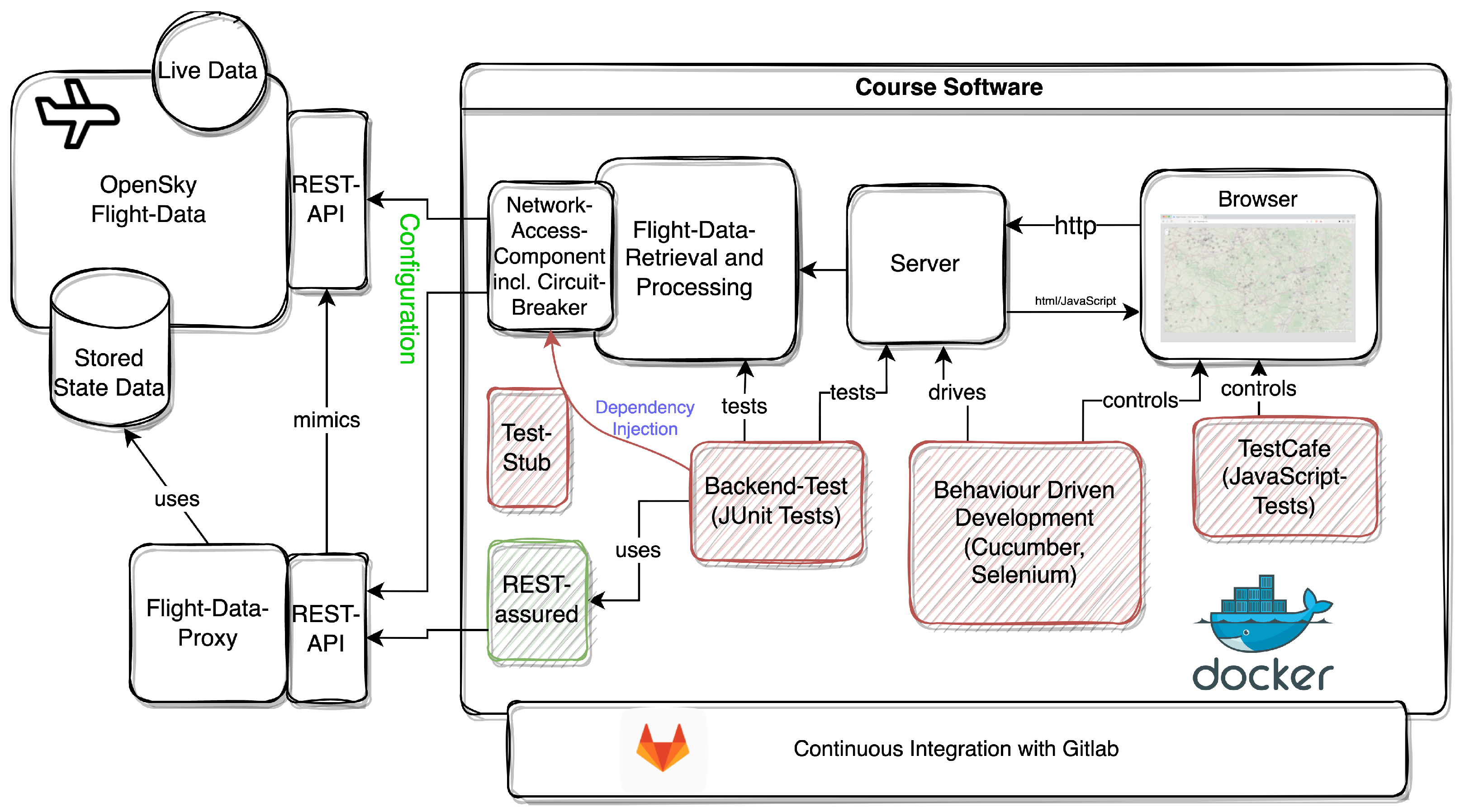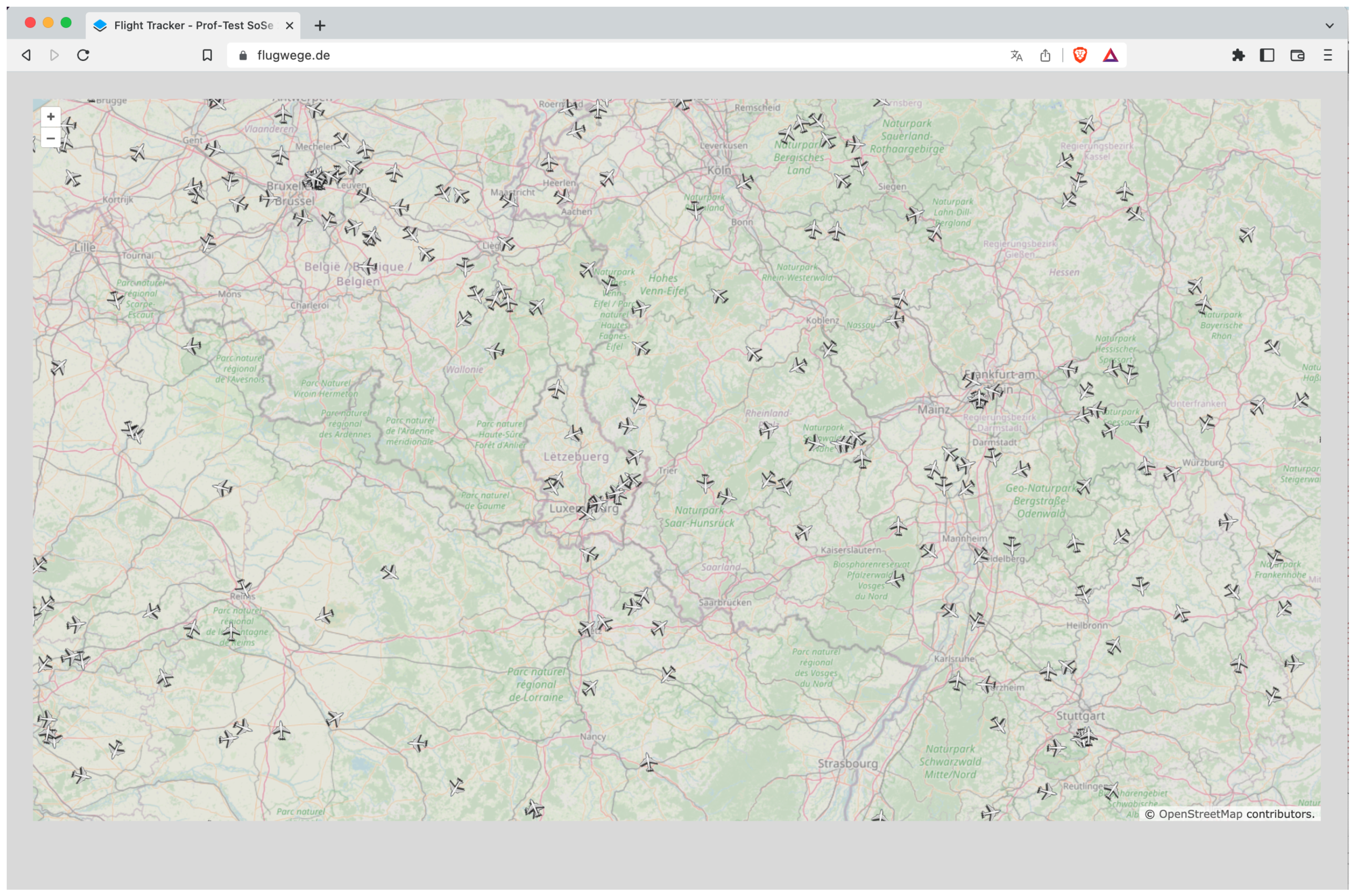1. Introduction
The need for a professional approach to the subject of testing software applications has now become part of all common software-engineering process models [
1]. For many students, this subject area is uncharted territory at the beginning of their studies. To motivate the need for testing, it makes sense at a university of applied sciences to work with real-world data and a comprehensible task. The freely accessible data of the OpenSky network [
2] represent an excellent opportunity to teach many aspects of software engineering in a lively fashion.
There exist already a number of excellent frameworks for handling OpenSky data, e.g., traffic [
3] or OpenSky-traffic-viz [
4]. However, the focus of the course is less on the deeper analysis of flight data and more on the aspects of data retrieval via standard interfaces such as REST and testing techniques for the implemented software. Therefore, these frameworks are not used in this particular setting.
While working with the OpenSky data via the API at
https://opensky-network.org/api/states/all (accessed on 13 December 2022) during hands-on sessions with groups of up to 16 students, the following challenges where discovered:
Restrictions on the update frequency for data-retrieval calls when using the same IP address from the university network;
The necessity to register for an OpenSky account in order to retrieve data for a specific timestamp;
A lack of student understanding of basic flight-data terminology, including geographic location.
The first two challenges could easily have been resolved by asking for a special treatment for the university access using a registered IP address or other means of identification. However, the author decided to use a more sustainable approach: because it is not necessary to use real-time data to learn software-engineering techniques, previously recorded flight data was provided via a locally hosted flight-data proxy.
The last challenge was not so easy to solve. Understanding and dealing with flight data requires a large amount of knowledge, which admittedly can only be built up by occupying oneself with the matter over a longer period of time. The approach to teaching the material to the students was to link common techniques of software testing to the actual processing of flight data.
During the 13-week course, the following testing techniques were among those taught (students spent an average of 4 h per week on the tasks):
Dependency injection and test doubles (including mocks and stubs);
Interface testing using REST assured;
Behaviour-driven development;
Test automation for a sample flight-track web application using TestCafe [
5] (including headless tests);
Using a continuous integration pipeline which includes automated tests.
Figure 1 shows an overview of the software components that were used for the course. The testing components are drawn with a red background. Almost all of the software (including testing) was run in docker containers, which created additional difficulties for some students but at the same time reduced the complexity of setting up a common infrastructure. Additionally, all tests where included in a continuous integration pipeline.
2. Flight-Data Proxy
In order to be independent of any limitations while accessing the OpenSky data, a simple flight-data proxy was implemented. Using one hour of recorded data (which is available through
https://opensky-network.org/datasets/, accessed on 13 December 2022) the proxy determines which flight data to return to a caller by matching the current minute and second to the equivalent time in the hour of the pre-recorded data. This means that the same hour of air-traffic is repeated every hour. This only reveals itself during the transition from the last minute of an hour to the first minute of the following hour. This limitation has not led to any problems during the course.
The flight-data proxy is not only used for testing the API (see the following sections) but also used as a data provider for a simple web application which is also used for testing purposes (see
Section 6).
As can be seen in
Figure 1, the network-access component can be configured to use either the original OpenSky-REST-API or the REST-API of the flight-data proxy.
3. Dependency Injection and Mocking
Dependency Injection is a well-known design pattern for creating loosely coupled software which is maintainable and testable [
6]. Course participants were introduced to this concept by being given the task of implementing a data-retrieval module that needed to access the flight-data proxy via the REST-API. In order to be able to test the flight-data processing without the need for a working network connection and also to have control over the test data, the students needed to use a dependency injection to inject a test double (this case required the use of a stub [
1] (pp. 93)) for provisioning the flight data. The test stub in
Figure 1 implements the same interface as the network-access component and is injected into the flight-data retrieval component by the backend test.
The flight-data stub had to provide the same data that a call to the API would retrieve over the network. This helped the students understand what data needed to be provided and also helped them figure out what the flight-data processing unit needed to do.
An additional technique that was taught during this exercise was the use of test-driven development (TDD). Although most students have heard of this technique, there is often some resistance to actually using it. The authors’ experience shows that the use of mocks and stubs encourages the application of TDD and helps students to appreciate its value for professional software testing.
4. Testing REST Interfaces with REST-Assured
In order for the students to learn how to test REST-full APIs, the well-established tool REST-assured (
https://github.com/rest-assured/rest-assured, accessed on 13 December 2022) was used in the course. During the implementation of the tests, the following issues needed to addressed by students:
What kind of request is required for the desired functionality (GET, POST, PUT, or DELETE)?
What is the expected answer?
What happens if the network connection is not working? Are there defined values for network timeouts?
Are values retrieved over the network checked for errors? Are there any vulnerabilities that might be exploited if the server has been compromised?
A small sample of a REST-assured call to check the provided data can be seen in
Figure 2 5. Behaviour-Driven Development
Behaviour-driven development (BDD) is an approach to testing using a language for tests which non-developers can understand [
7]. A commonly used implementation for this scheme is cucumber using the testing language called ’gherkin’ (
https://cucumber.io/, accessed on 13 December 2022). Tests are placed in ’feature’ files which are then processed by cucumber and transformed into test-function calls. A sample for such a test can be seen in
Figure 3.
In the context of the course, BDD was used for testing features in the backend and the frontend. The latter was implemented using the end-to-end-testing tool Selenium (
https://www.selenium.dev/, accessed on 13 December 2022). This approach helped the students to understand and implement the required test infrastructure, where a test server and a test browser had to be activated in order for the tests to function. An additional challenge was the integration of the cucumber tests in the continuous integration pipeline.
6. Test Automation for a Flight-Track Web Application
A very important part of the course is the teaching of how to setup end-to-end tests using test automation tools for web browsers. There are many tools freely available: Cypress, Selenium, TestCafe, and others. For this course, TestCafe (
https://testcafe.io/, accessed on 13 December 2022) was chosen, because it was easy to setup and the tests can be understood and written quite easily.
A very simple flight-tracking web application was implemented using the OpenLayer-Framework (Version 7.1,
https://openlayers.org/ (accessed on 13 December 2022) in conjunction with the flight-data proxy. This application is shown in
Figure 4 and can be accessed at
https://flugwege.de (accessed on 13 December 2022). The flight positions are updated every 10 s using a websocket connection.
A pretty difficult task for the students was to implement a complete testing stage, which included a dummy flight-track server and a browser which was running in headless mode being controlled by TestCafe.
Many students also had trouble finding an intentionally placed bug in the web application: The rotation of the flight symbols was just carried out using the true_track value of the state-vector directly. The OpenLayer-API expects graphic symbols (icons) to be rotated using a radian value. When pointing out this issue, the importance of reading and understanding the used data and APIs was immediately understood by the students.
Other issues with regards to web-application testing where only briefly addressed:
7. Results
The evaluation of the course by the students was consistently very positive. A summary of the evaluation can be seen in
Figure 5: the number range on the right-hand side goes from 1 (very positive) to 6 (negative). An English translation of the different areas was added. Significant feedback revealed that the practical reference to the flight data was very helpful and resulted in learning the relevant techniques well.
Some students noted that the subject matter (especially the handling of flight data) was quite demanding. Unfortunately, due to the heavy workload of students in other courses, additional engagement with the topic was not observed. The bug described in
Section 6 concerning the incorrect rotation of the aircraft symbols was not fixed by all students, although the display then remained incorrect.
Overall, the number of test methods and tools used in the course is quite high. This poses a certain challenge for the students. However, it is also possible to learn many different approaches and then apply them in other contexts.
Some aspects of the course not mentioned in this article also deal with techniques for testing asynchronous code or testing multi-threading.
8. Conclusions and Further Work
For the future of the course, it is planned to focus the use of the test tools even more on the underlying software architecture. Currently, the tasks are partially detached from each other and it is sometimes not so easy for the students to classify the topics in relation to each other.
In addition, the author would like to incorporate the aspect of end-to-end testing more deeply. In particular, the issues of the correct representation of flight-data symbols on the website should be implemented in the future with newer approaches (e.g., image recognition and AI).
Due to time constraints, the area of mobile testing is also currently not addressed in more detail on the course. Especially for this area, the flight data of the OpenSky network is particularly suitable and should be considered in the future.
Furthermore, it is planned to make the course materials available as open source in order to establish an exchange with other interested teachers (and students).










